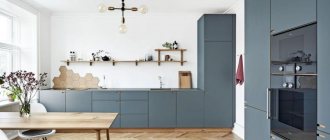Updated: September 2, 2021
The combination of colors in the interior is the basis of the design of premises and especially living spaces.
Everything depends on how the right color and shade is chosen in the room! Will it be comfortable, how often will you have to clean it, and will you even want to sleep, eat, or dance?
Therefore, it is extremely important to understand the basic principles of interior color, even if you have started a turnkey renovation from the most eminent metropolitan designer.
We'll talk about them today.
- White
Itten circle in the interior: what is it
Itten's color wheel is a cheat sheet for choosing shades. This is a spectrum of tones that form various combinations with each other. With the help of such an invention, you will quickly and accurately determine successful combinations for the interior. You can weave into your design even such unusual shades as marsala - the color of tart red wine, which has become a fashion trend and a favorite of experimenters.
The spectrum is based on the basic colors: red, yellow, blue. The remaining shades are formed as a result of their combination. The result is a variety of tones that differ from each other in brightness and contrast.
It is difficult to determine successful combinations of shades by eye. It is even more difficult to correctly combine warm and cold tones in the decor. With the help of a circle you will learn how unusual harmonious color ensembles can be created. An example is the use of lavender in tandem with other tones.
Variant of Itten's color wheel
Chandeliers
When searching for a chandelier for your style, you need to take into account the nature of the ornament, the degree of expressiveness, shape, and size. A modern home may include a chandelier with a trendy design made from metal pipes or an interesting spherical shape. If your home has a mixed style, almost any model will work to incorporate into your room.
An expressive element in the bedroom
Black chandeliers attract attention with their expressiveness; due to the bright visual contrast, rhinestone inlay or other decorations are better visible on them. Whether you love the rustic beauty of wrought iron chandeliers or prefer the glamor of a crystal chandelier, look for a design to suit your taste.
Such models attract attention with their expressiveness
Wrought iron chandeliers
Exquisite wrought iron designs are surprisingly versatile, making them suitable for modern, industrial or mixed styles. Black chandeliers are a minimalist's dream, especially next to pure white walls, simplistic decor, and the combination of wrought iron construction with wooden details is a successful combination of rustic charm and natural beauty. Here are some ideas for installing this decoration indoors:
- Wrought iron kitchen lighting will create targeted lighting as these models can be installed over a specific area;
- Hang a pendant chandelier above your bed or in your living room seating area to illuminate a central area.
Black chandeliers are a minimalist's dream
A wrought iron chandelier can come in different designs and degrees of complexity, but it has beauty and complexity with a simple design, especially when combined with different materials.
Consider a chandelier that includes two or three tones of metal—for example:
- bronze;
- copper;
- wrought iron.
Add elements of glass or acrylic, metal, ceramic details or even hints of wood.
This model can be supplied in various designs and degrees of complexity.
Iron
An iron chandelier will open up any space with strong, clean lines. Regardless of the design, it amazes with its simplicity, unusual approach to modern lighting - it is both a trend and a classic. Antiqueness and the patina of time are another effect that can be achieved using metal on a chandelier.
While transparent glass, brushed steel, minimalist silhouettes will create vintage elements. Try a tiered chandelier for a statement look, or choose fixtures with intricately cut crystals and hand-forged swirls.
Regardless of the design, this option is striking in its simplicity.
Khrustalnaya
Weave a little sparkle into your ceiling lighting with metallic fixtures adorned with sparkling crystals. These designs are made to channel the power of light in the most glamorous way. Use it for a traditional style with wrought iron, or consider a crystal chandelier covered in shimmering glass rhinestones. Prefer a decadent approach to your ceiling lighting? Choose wrought iron chandeliers with crystals cut into prismatic geometric shapes or fitted with black crystal clusters.
These designs are made to channel the power of light in the most glamorous way.
There are many chandeliers in black finish that are suitable for homes with a particular style.
Tip When choosing these lamps, pay attention to wrought iron chandeliers with a darker metal finish or glass chandeliers with black crystals that fall in decorative drops.
For a Modern model that is not overly decorated, but not overly decorated, you may be inclined to choose bronze or nickel. Many chandeliers in these metals have a laconic design, a simple, but not simplistic appearance.
Unusual and stylish option
With black trim
Hang a classic iron chandelier in a country style for a sophisticated addition to a casual setting. Or try a black glass chandelier paired with distressed wood accents for a simple approach to industrial themes. These dark themes will be paired with solid wood, warped metal complemented by matte black finishes and polished gold frames. Whether you want simplicity or luxury, a black chandelier will always complement your preferred aesthetic.
Modern style
How to use the Itten circle in the interior
There are several schemes for working with a spectral cheat sheet. Each is based on a combination of different types of shades. There are ten combinations in the circle of color combinations in the interior:
- Main;
- Composite;
- Complex;
- Additional;
- Contrasting;
- Related-contrasting;
- Related;
- Monochromatic;
- Neutral;
- Achromatic.
You will find a detailed analysis of shades in the video. Your main initial task is to understand the basic principles of combining shades. We offer simple schemes.
Monochrome
Another name is analog. To get a successful combination, you need to take three adjacent shades on the circle. These will be tones from the same color scheme that will play in the interior in exactly this combination.
Complementary
This scheme is otherwise called contrasting. The combination is made of two shades located on opposite sides of the circle. Sometimes it seems that these colors cannot be combined, but they look amazing in decor.
Triad
The combination is based on three main tones. To choose them correctly, build a triangle with equal sides on the color wheel for interior designers. You can use bright pure shades or midtones. In the second case, you will get a calmer, unobtrusive decor.
Polychrome or tetrad
Color composition: main tone, two additional and one accent. To find it, you need to inscribe a square in the circle of the spectrum and take the shades that will be in the corners. This scheme is suitable for many modern interior styles. If you find the right combination, such a design will become a design find for your home or apartment.
Color Selection Schemes
Examples of using schemes for choosing shades
Briefly about the main thing
Color is the most powerful component of any interior. Learning to control a person’s consciousness through it is not so difficult. It’s enough just to use the circle of colors correctly. The laws of nature already contain harmony. You just need to reproduce it correctly.
And in order to master color faster and better, you need to pay attention to self-development. There are many training courses on the Internet that guarantee employment as an interior designer. You can complete the entire course or buy individual blocks dedicated to color.
Also, for general development and professional growth, you need to constantly read specialized literature. This will create a theoretical basis, practical skills and expand the general understanding of the role of color in human life.
Thanks to such knowledge, you can easily design the interior of each room in your home and start earning decent money from this skill.
Sincerely, Tatyana Fedorchenko especially for the proudalenku.ru project
Laptop for a designer
Interior designer salary
Archicad training
How to become a designer
Profession Interior designer
Landscape designer
Complex combination of shades
The most popular and versatile way to create stunning decor. The color scheme is based on classic tones: white, beige and gray. They can be combined with other shades, correctly placing accents. If you want changes in the future, you can leave the basic colors and complement them with new colors. An option is to use pink in decor.
To combine classic shades in the interior, it is not necessary to use a color wheel. However, with its help it will be more convenient for you to distinguish even the slightest tints of tone and catch the contrast. You can use special online programs to select shades.
An example of a complex combination of colors in the interior
Stylish kitchen
The kitchen is one of the most visited places in the apartment. It should be functional, comfortable, but at the same time, you want it to look beautiful and tasteful. It is clear that large cabinets may not always be visually attractive. In such cases, a black glossy surface will come to the rescue, making them smaller and more stylish. In the kitchen, a variety of items can be black. One of the most spectacular and popular solutions recently is a black set with a contrasting tabletop.
Indeed, it looks expensive and laconic.
Matte surfaces can imitate the surface of wood, while glossy ones go well with transparent glass facades. If the kitchen is small, it is better to give preference to a white set, but use a dark color for the work area . This will visually deepen and distance the wall. Any materials can be used - from traditional tiles to glossy black tempered glass.
Against the background brickwork, metal kitchen utensils hung on a long stainless pipe will stand out well, or vice versa. You can diversify the interior with household appliances in monochrome black or in combination with stainless steel. Agree, a white refrigerator is clearly inferior in terms of visual appeal to black or at least gray models.
Often such a bulky item is transformed from an inappropriate highlight into a beautiful accent simply by changing its color. And how unusual black ceramic glass hobs look! An oven selected according to its design will become barely noticeable. Black glass tables look amazing combined with light chairs on black legs. You can do the opposite - a black kitchen corner upholstered in leatherette is complemented with a transparent glass table. Even a variety of containers for storing spices, made of dark ceramics, are enough, which will be beautifully arranged on a small shelf to create a beautiful contrast.
Gradient in the interior: a technique for creating exquisite wall decor
If you have mastered the color wheel for the interior of a room, you can choose shades and create soft tints. Use a monochrome scheme on the spectrum for such decor. The main rule is to move from a dark tone to a lighter one. The photo shows how much a room with a gradient design transforms.
Example of using a color gradient
Advice! To visually enlarge the space, it is better to apply a dark tone closer to the floor, and a light tone to the ceiling.
Dark-light
We finally decided on the colors. But how to choose the right tone? Dark? Light? And how to combine them? Shade compatibility depends on the task.
You can, for example, take selected colors in very light tones. The interior will be light and delicate. This is an excellent solution for children's design.
Or you can use the most saturated colors. This will make the room bright, atmospheric, inspiring and energizing, so this option is not very suitable for the bedroom. There it is better to use calmer tones.
Or you can take one or several soft shades and one rich one. The colors “work” together, complementing and highlighting each other. Against the background of delicate pastel tones, the bright color will sound completely new. Try it!
Character of color: warm and cold tones
Some colors evoke associations with summer and the sun, others with coolness, wind, ice cubes, and sea breeze. The first ones will be warm, and the second ones will be cold.
Warm colors contain more yellow pigment, cool colors contain more blue pigment. To understand the principle, the Itten color circle can be divided into two parts, as shown in the photo. In one sector there will be warm tones, in the second - cold.
There is a third group of shades - neutrals. Examples: black, variations of gray, white. Such tones do not evoke associations with yellow and blue, and therefore do not have a conventional thermal color. But they serve as an excellent base for combinations of shades. There are several ways to create a stunning interior with neutral colors.
Scheme for determining cold and warm colors on a circle
Furniture
An excess of dark tones can be depressing, but their moderate use gives the room austerity, comfort and coziness. Using black furniture has many advantages:
- practicality, functionality;
- neutrality, compatibility with any details;
- sophisticated, elegant look;
- increasing the brightness of neighboring tones;
- giving contrast to the room;
- creating a mysterious, subdued atmosphere.
Black furniture: wardrobes, sofas, beds - goes well with any household appliances. This is especially true for the kitchen, where a dark set will favorably emphasize the whiteness of the hood, refrigerator, electric or gas stove. A set of light wood shades with a black countertop and sink will look original. In the office, dark-colored furniture symbolizes rigor, elegance, and formality.
Despite the obvious advantages, overloading with black furniture will cause a feeling of gloom, so when decorating a room you must adhere to the following rules:
- blackness requires an abundance of light and space in the room;
- the best background for dark furniture is light walls;
- products should be as elegant as possible, massiveness is unacceptable;
- contrasting accessories soften the overall picture;
- in the living room or bedroom, the ideal “pair” for black sofas, walls, and cabinets will be light carpets with long pile.
How to decide on shades using a designer's circle to select colors in the interior
Experienced designers are guided by professional skills when choosing colors. And you can use their advice and add your preferences. 5 simple rules to help:
- Choose 3 main shades and combine them in your design. You should not get carried away with a large number of colors and create an excessive riot of colors - this is a sign of tasteless decor;
- Maintain a balance between warm and cool shades. Dilute the selected range based on the color wheel for interior designers;
- Remember that in a polychrome interior, the base shade accounts for approximately 60% of the decorated area;
- Use different shades of your favorite colors. To make the design stylish and harmonious, try to fit into the initially chosen range;
- Don't ignore intuitive choices. Analyze your favorite shades and try to understand what associations resonate with you when you see them. For example, you prefer green clothes because you feel comfortable in them. Perhaps this tone will also be appropriate in the interior.
Attempts to keep up with fashion trends in decor without relying on the type of room and personal preferences will fail. The interior must first of all be comfortable to perceive. A striking example is the correct use of pink in design.
Psychology of color: what shades are associated with
Each shade is reflected in the human soul, so it is wise to select colors from a psychological point of view. The right colors in the interior help you cheer up, calm down, get ready for work and even fall asleep. And on the contrary, even your favorite shade can depress the nervous system. Do you plan to regularly update your interior? Then immediately select the optimal combinations. Let's look at popular shades and their effect on the body.
White
If we consider the circle of colors for the interior, then white is not a shade, but the absence of color. But this does not prevent it from being both a base for other combinations and an independent tone in the interior. Associations with white: peace, freedom, wide space. This color visually increases the area of the room and harmonizes with bright shades. Secrets of using white will help you create a unique design.
An example of using white in design
Red
People have radically different associations with this color. Some perceive it as an aggressive shade, while others find it warm and invigorating. Red shades awaken the appetite, but can be very tiring. It is better to use it in doses, for example, in the design of accessories or as a bright spot against the background of other color combinations.
An example of using red in design
Terracotta color in design has similar properties. Like red, it excites the imagination, creates an exciting atmosphere and warms with warmth.
Black
If we take into account the Itten circle and color harmonies in the interior, then black is an accent shade. It perfectly complements other tones and creates a feeling of mystery. If you need to create an amazing ambiance and some intrigue, feel free to use it in your design. Here are a few ideas to help you experiment with black.
An example of using black in design
Orange
Orange is an energetic, rich color that creates a good mood and encourages communication. With the help of orange shades you can revive an unsuccessful interior and add brightness to the room. It is also recommended to use it in kitchen decoration because it stimulates the appetite.
An example of using orange in design
Advice! Orange makes cool tones more expressive and deep.
Grey
This color is rarely used as a main color because most people find it depressing. Shades of gray are good to combine with bright tones. In tandem with other colors, they acquire depth and evoke a feeling of peace. From another article you will learn how to successfully integrate gray color into the decor of rooms.
An example of using gray in design
Brown
It is a neutral color that blends in with most other shades. It evokes pleasant associations with reliability, protection, and tranquility. And brown can be the base color in any room. This is an ideal option if you want something original and discreet. We offer ideas for using brown in decor.
An example of using brown in design
Violet
Alluring, luxurious and mysterious purple evokes conflicting feelings. The abundance of this shade can make you nervous and tiring, but moderate use will give you a feeling of comfort and euphoria.
An example of using purple in design
Blue
This is a shade of a cold range, judging by the color wheel of combinations in the interior. Blue visually increases space and calms. Can't get ready for work or household chores? Use shades of blue in your decor. They are suitable for any room - from the nursery to the bathroom. Find out more about how to wisely use blue in the interior.
An example of using blue in design
Green
The color of nature, peace and relaxation. In the green room you will feel cozy and calm. However, you should be careful with shades - too dark ones can provoke depression. This range is best combined with other cool colors and neutral tones. The designers gave some tips on how to decorate a room using green. We also offer options for using shades: noble olive and alternative pistachio.
An example of using green in design
Yellow
A pleasant sunny tone tones and increases concentration. The color has many shades, including delicate cream ones. Yellow is a reliable assistant in creating comfort, but some may find it intrusive.
An example of using yellow in design
Blue
This color has a magical property - it can normalize blood pressure. If you need a cozy corner where you can completely relax, incorporate shades of blue into your decor. The Interior Designers Color Circle states that it is a cool tone that will visually expand a small room.
An example of using blue in design
FAQ
Is it possible to become a designer without special knowledge of color?
Yes, no one forbids interior design. And most people do just that when redecorating their bedroom or bathroom. It's worth noting that sometimes you get really good rooms.
But knowing the theory will help you implement your plans faster, correctly combine colors, and improve seemingly good ideas.
Is it possible to learn how to use palettes on your own, or is it necessary to enroll in design courses?
It all depends on the individual characteristics of the person. For one, it will be enough to simply read specialized literature, how to choose a color for a room, and watch open lectures by professionals.
Other students must have a strict mentor who will explain every nuance, monitor the completion of all tasks, and help correct mistakes.
Another important advantage of any course is the issuance of a certificate after completion. This will help in your professional activities. But, answering the question, it can still be argued that you can master color painting on your own.
Will knowing how to work with color help you make more money?
Today, many people decide to use the services of professional designers. And with relatively low competition in the market for such services, the demand for specialists in the decorative renovation planning industry remains consistently high. Even in a small city you can develop a large customer base.
The Internet expands the possibilities for providing services, especially if the customer does not require the presence of a contractor during the implementation of the finished project. All this allows us to make interior design the main source of profit.
Style and color: recommendations for different directions
When choosing a color, do not forget about the canons of interior styles. For everyone there are preferred tones that fully reveal the features of the direction. To confidently choose shades, open the Itten color wheel online or study the table.
| Style | Preferred colors |
| Classic | White, beige, brown |
| Modern | Green, blue, beige, gray, brown |
| Baroque | Combination of pastel shades |
| Eco | Beige, grass, brown |
| Loft | Dark grey, blue, green, red, orange |
| Provence | Pink, beige, blue, milky |
| Country | Brown, muted yellow, brick |
| High tech | Metallic, grey, black, white |
It is much more difficult with the directions of fusion and futurism. These directions allow you to use a riot of rich colors. Within these styles, you can experiment with bright tones: turquoise, light green, yellow. To tone down too loud combinations, include white in the combination.
Now it is fashionable to use fuchsia color in the interior. This tone can also be found on the color wheel of combinations and correctly fit into the decor.
Floor
A dark floor not only looks aesthetically pleasing, but allows you to spend less time on cleaning. On the one hand, dust particles are sometimes more visible on a dark surface. But light wet cleaning is not as difficult as removing caustic stains from light-colored surfaces. Therefore, floors in charcoal shades are in demand in kitchens, hallways and rooms where there are often a large number of people.
An interesting effect can be achieved by combining black. White tiles, staggered with dark ones, are an integral part of the popular retro Pin-Up style. Graphite looks organic not only in materials that imitate natural stone. Black laminate, repeating the pattern of natural wood, finds a well-deserved place in rooms decorated within the Scandinavian style or loft flow.
Shades for different rooms
For every room there are preferred and undesirable tones. For example, some are good for decorating a kitchen and are completely unsuitable for a living room. The color wheel of shade combinations in the interior of a bedroom, bathroom and other rooms will not let you get confused. In the table you can see the most popular solutions.
| Room | Colors |
| Kitchen | Yellow, red, orange, turquoise |
| Hallway | Green, beige, blue, yellow |
| Bedroom | Pastel shades, gold, silver, purple |
| Living room | White, beige, grey, brown, yellow |
| Cabinet | Blue, brown |
| Bathroom | Blue, pink |
We offer variations on the theme of kitchen design: rich design in purple tones and luxurious decor in green. If you prefer dark colors, you can use shades of blue.
Bedroom decoration also has its secrets. The room should be conducive to comfortable rest and tranquility. If you haven't decided which design to go for yet, check out the best bedroom makeover ideas.
For a children's room, it is better to choose light base colors and complement them with bright accents. Do not use flashy acidic shades - they negatively affect the child’s psyche. Be careful with red - this color can also cause overstimulation.
The bathroom is your personal spa. Why not create a cozy island there, reminiscent of gentle sea waves and clear skies using shades of blue in the interior.
The charm of the black and yellow pattern will make any interior interesting
PreviousNext
The combination of black and orange was once used by knights to emphasize honor and valor. But in our time there are no knights left, but there is an association with Halloween and poisonous insects and reptiles. But still, even today, the meaning of courage has been preserved, since the celebration of Halloween is a victory over the fear of dark forces. What does this have to do with the interior? And the most direct thing. Knowing these nuances, you should not use both colors in equal quantities. And it is better to take black in not too saturated tones; besides, you can dilute this combination with white, gray or brown tones. But under no circumstances should you decorate a children’s room with this combination, it will have an overstimulating effect on them.
Colors that should not be combined
On the color wheel you can see shades that are not in harmony with each other. This does not mean that they cannot be combined at all - if you want to experiment, give free rein to your imagination. To make it easier to be creative, study the most insidious combinations.
| Main color | Which ones doesn’t go well with? |
| Red | Yellow, chestnut, red-yellow, brick, purple |
| Orange | Red |
| Pink | Brown, purple, lilac, red, blue |
| Yellow | Pink, burgundy |
| Burgundy | Brown, red, purple, gold, blue |
| Blue | Burgundy, purple, lilac |
| Violet | Brick, terracotta, red |
| Lilac | Gold, pink, burgundy, red, blue, terracotta, brick |
| Blue | Pink, brown, green, brown, lilac |
| Grey | Terracotta, dark brown, beige |
Mistakes when choosing colors
Sometimes stylish interiors from pictures look different in reality. It is enough to miss some detail and choose a different shade, and the result will negate your efforts. To avoid failure, you can find a circle of color combinations in the interior online, although this is not a panacea for mistakes. And for clarity, we will give examples of unsuccessful interiors.
Abundance of white
The completely white room is more reminiscent of a hospital ward. Don't forget about accents - they will help diversify the design and avoid boredom in the interior. Sometimes one bright detail is enough: a sofa, curtains, painting or carpet.
Mistake in using white color in design
Thoughtless implementation of trends
Somewhere you saw an interior entirely in beige tones and want to repeat it? There is a risk that the room will resemble a cardboard box. The photo is just an example of unsuccessful design.
Bad design with beige color
Poor combination of artificial lighting and color
Sometimes light radically changes the perception of shades. When choosing a color, think about how the room will look under artificial lighting. It is quite possible that terracotta will turn into oppressive red, and dark gray into gloomy black.
Example of color change under artificial light
Combination of incongruous
If you use a spectral circle to select colors in the interior, the likelihood of error is much less. Relying only on fashion trends and the tastes of family members, you can create a flashy, inorganic design.
An example of an unsuccessful color combination in the interior
Aggressive use of contrasts
The design uses the technique of “playing on contrasts.” However, in reality you should be more careful with its implementation. See how you can hopelessly ruin your decor with the wrong combination of shades.
Error when using contrasting colors
Using one color
Monotony will easily spoil the interior and undo your work. The predominance of one color, even in different shades, will visually “heavien” the room and create a negative impression. For example, instructions on how not to make mistakes when using beige.
Poor design in one color
Ceiling
Ceilings painted black, if the colors are incorrectly combined, can visually reduce the height of the room. The situation is completely different with a tension structure: thanks to the gloss and partial specularity, such a surface, on the contrary, will increase the height of the room.
The glossy French ceiling looks aesthetically pleasing in the living room, hallway and bedroom. But thanks to simple cleaning and modern exhaust systems, installation of such a structure is also appropriate in the kitchen. In a small bathroom, such a ceiling will create the illusion of additional space.
The combination of several colors when choosing a ceiling scheme allows you to divide the room into zones. This technique can be used in small smart apartments. By choosing black for the ceiling above the sleeping area and contrasting white for the living room area, you can visually delimit a small room.











